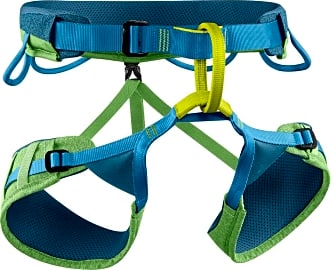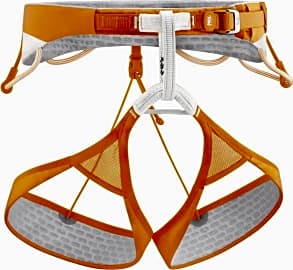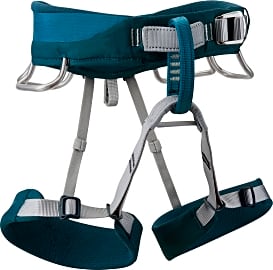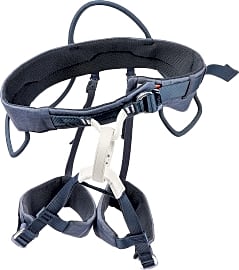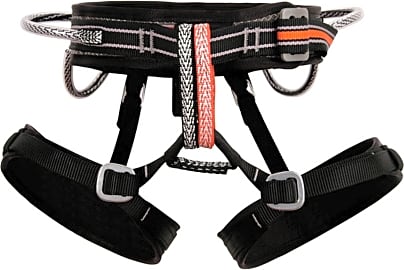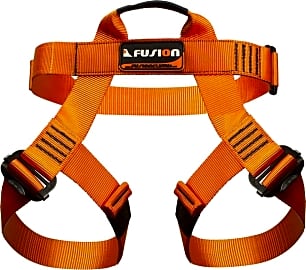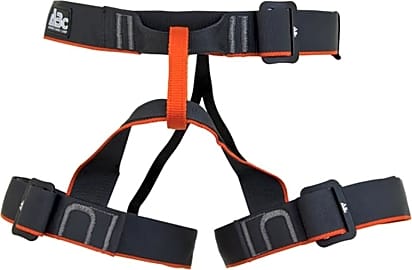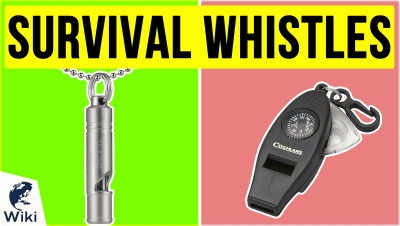The 10 Best Climbing Harnesses

This wiki has been updated 37 times since it was first published in September of 2015. Whether you're tackling a summit or rappelling down a sheer rock face, you need to be sure your gear will keep you safe, so pack one of these harnesses for your next adventure and leave any worries at home. They come in many size and weight capacity options to fit most sizes, and are suitable for many styles of climbing, from beginners in the gym to experts in Yosemite. When users buy our independently chosen editorial selections, we may earn commissions to help fund the Wiki.
Editor's Notes
October 20, 2020:
This list includes a variety of climbing harnesses that all have their own strengths. Some are more simple, such as the Oumers Half Body or ABC Guide. These offer non-padded, adjustable leg loops and waist bands. They are ideal if you’re just getting started with climbing as the simple belay loops are very easy to learn with. Many climbing gyms offer these types of harnesses as rentals because they’re safe, versatile, and fit many body types.
For more advanced climbers, or for climbers who have a specific type of climbing they enjoy, we also included some options that have more specialized features. The Petzl Corax and Black Diamond Momentum both have padding in the legs and waist, making them a little more comfortable for hanging and belaying. The Petzl Adjama has the ability to carry a lot of gear and is comfortably worn with a pack, making it a good option for extended trips.
We replaced the Petzl Adjama and the Edelrid Jay II with their updated versions. The Petzl Adjama was improved with new fabrics, a more comfortable waistband, and adjustable leg loops. For the Edelrid Jay III, they added internal red fibers in the belay and tie-in points to indicate when it’s time for a new harness. We also replaced the Arc’teryx AR-395a with the Petzl Sitta. The Petzl Sitta is at a similar price point and is an extremely lightweight option that is also very versatile. The Sitta also offers more comfort when hanging, belaying, and standing.
The History Of Climbing Harnesses
Gym and sport climbing calls for speed and flexibility, and harnesses designed for that activity tend to be thinner, lighter, and more stripped down than other kinds.
If you're a climbing enthusiast, you know that having a good harness is as important to you and your sport as comfortable shoes are to a runner, or a good pair of skates to a hockey player. Not only can your technique and enjoyment hinge heavily on what kind of harness you wear — anyone who's spent 20 minutes dangling from a rock face in too tight or too loose a harness can attest to this — but your personal safety depends on it, too. Finding the right one, therefore, is important, whether you're a beginner or a hardcore practitioner.
Climbing harnesses have been around in some form or another for as long as people have been hitching themselves to rope in order to scale obstacles or traverse difficult terrain. In its most basic form, a harness can simply be a piece of rope or a strap tied around the waist and thighs to support one's body weight. This can be a useful safety tool, and is indeed used today as a safety tool in a number of different situations, including by first responders in emergencies and construction workers on building sites. But it's in the sport of rock climbing where the harness has perhaps made the largest impact.
The first harness invented specifically for climbing purposes dates back to the early 19th century, and is usually attributed to Jeanne Immink, a Dutch mountaineer who is also credited as being a pioneer in women's climbing. It wasn't until the next century, however, after British climber Don Whillans wore a specially designed harness during an expedition up Annapurna's South Face in 1970, that the piece of equipment became more widely adopted.
Today, harnesses can come in as many shapes and styles as there are iterations of the sport. Gym and sport climbing calls for speed and flexibility, and harnesses designed for that activity tend to be thinner, lighter, and more stripped down than other kinds. Trad climbing requires the hauling of lots of equipment, and its harnesses incorporate larger and more numerous gear loops, sturdier reinforcements, and thicker padding. In alpine climbing and mountaineering, you may not wear a harness the whole time, so these tend to be loose and easily adjustable, allowing you to put them on and take them off in a hurry.
There are also specialty harnesses, as well as harnesses that combine different aspects of the aforementioned, such as those for ice climbing, which are well-padded, but also light and flexible.
Examining The Anatomy Of Climbing Harnesses
Harnesses may vary slightly depending on their application, but most do share a general anatomy. Understanding the different parts of a harness is an essential step in choosing the right one, not to mention in using it correctly once you get it outside.
Harnesses may vary slightly depending on their application, but most do share a general anatomy.
The average harness consists of a waist belt, sometimes called a swami belt, connected to two leg loops by thin nylon webbing or elastic at the back and front. Depending on the type of harness, these can incorporate different degrees of padding, or, in the most basic models, none at all. The waist belt should have one or two strong metal buckles at the front for fastening the harness securely to the body, while each leg loop may or may not have adjustment mechanisms.
Many harnesses will also have gear loops, though the number, size, and nature of these will vary. As previously mentioned, trad climbing harness should have large, possibly metal loops for holding carabiners and quickdraws, while on sport climbing harness these loops may be made of nylon or some other soft material. The haul loop is positioned at the back of the waist and is used to attach a second rope, though not all harnesses will have this.
Two of the most important parts of the harness, at least in terms of safety, are the belay loop and tie-in points, which together connect the two leg loops to the waist belt at the front. The belay loop is usually the strongest part of the harness and the only piece that is load-tested, while the tie-in points are separated to help distribute weight. It's important not to confuse the two, as the former, though tough, is not designed to attach to your main rope.
Taking The Proper Safety Precautions
As in all sports, safety is a chief concern — though that may be even more true when it comes to rock climbing. Not every hobby has its participants scaling thousand-foot rock faces using little more than their hands and some rope.
Before buying a new harness, make sure its meets industry safety standards.
Before buying a new harness, make sure its meets industry safety standards. Most reputable commercial climbing harnesses should be approved by either the International Mountaineering And Climbing Federation or the European Committee Standardization, both of which have developed strict guidelines manufacturers must follow to ensure the reliability and durability of their products.
Considering their purpose, climbing harnesses are an area where you should let yourself splurge a little — it's better to spend a little more and get a good-quality harness than hold back and have to worry later whether your equipment is going to fail.
If you're a climbing beginner, learn the ropes — literally. Most rock gyms and parks should offer resources to novices just getting into the sport, including lessons on how to properly fit your harness, tie the appropriate knots, and belay your partner. There's really no better way to figure out how to use your equipment safely and effectively than being taught by someone who does.



